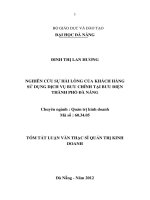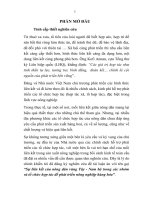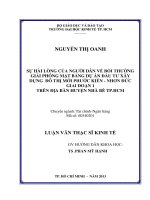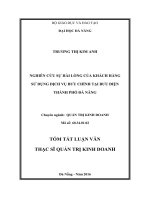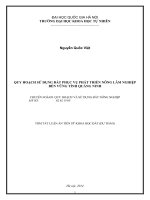Luận án tiến sĩ kinhsự hài lòng của công dân với các dịch vụ hành chính công ở ủy ban nhân các phường thuộc quận tây hồ
Bạn đang xem bản rút gọn của tài liệu. Xem và tải ngay bản đầy đủ của tài liệu tại đây (2.05 MB, 163 trang )
CITIZENS' SATISFACTION WITH PUBLIC ADMINISTRATIVE SERVICES AT
THE WARD PEOPLE’S COMMITTEES OF TAY HO DISTRICT
A Dissertation
Submitted to
Thai Nguyen University of Economics and Business Administration and
Central Philippine University Joint Program
In Partial Fulfillment
Of the Requirements for the degree
DOCTOR OF PUBLIC ADMINISTRATION
By
HOANG VAN HAO
December 2016
i
ACKNOWLEDGMENTS
It is hard to imagine how this dissertation could have been completed without the
encouragement and support from my academic supervisor, family and friends.
Firstly, I wish to thank my academic supervisor, Dr. Reynaldo Dusaran. It is my
honor to receive his guide, suggestions and feedbacks on each chapter with great patience.
Although we live in two different countries, the academic discussion has not been
influenced. Both direct and indirect meetings between us have been really effective. These
have helped me improve my expertise and insights, which finally has improved the quality
of this study.
I am also deeply grateful to my family, who has provided me with unconditional
support throughout the whole process. Over the last four years, I have two sons. My wife
has taken the responsibility of taking care of our sons. She has never complained about it
so that I can fully focus on studying. Furthermore, she has read and given valuable
opinions about this dissertation so that the content is expressed more precisely and
professionally. Next, I would like to send my gratitude to my parents. They have helped
much in looking after our sons. I am deeply indebted to my parents as they provided such
help while they were in worse health than before. My parents have only heard about the
university from us, but they have been always ready to try their best to ensure my sisters'
educational quality as well as mine.
Finally, I would like to thank my friends who have shared their research
experience, especially in collecting and analyzing the data. I also send my loyal thanks to
my peers in this PhD course who have brought to me many more experiences in study,
work and life as well. I really look forward to working with them in the future.
ii
TABLE OF CONTENTS
PAGE
ACKNOWLEDGMENTS
i
LIST OF FIGURES
iv
LIST OF TABLES
v
ABSTRACT
vii
CHAPTER
I. INTRODUCTION
1
Background and Rationale of the Study
3
Objectives of the Study
7
Hypotheses
7
Theoretical Framework
8
Conceptual Framework
15
Operational Definitions
19
Significance of the Study
24
Scope and Limitations
25
II. REVIEW OF RELATED LITERATURE AND STUDIES
27
Service Quality
27
Customers Satisfaction
35
Public Administrative Service and Citizens’ Satisfaction
37
Related Studies
41
iii
III. RESEARCH METHODOLOGY
46
Research Design
46
Population, Sample Size and Sampling Technique
48
Research Instruments
50
Data Gathering Procedure
59
Data Processing and Analysis
60
IV. DATA PRESENTATION, ANALYSIS AND INTERPRETATION
Respondents’ Characteristics
62
62
Respondents’ Perception of the Components of the Public Administrative
Services
67
Respondents’ Perception of Satisfaction with Public Administrative Services 71
Differences in Citizens’ Perception of Public Administrative Services and
Satisfaction according to their Personal Characteristics
72
Relationship between Citizens’ Perception of Public Administrative Services
and their Satisfaction
V. SUMMARY, CONCLUSIONS AND RECOMMENDATIONS
83
90
Summary of the Key Findings
91
Conclusions
93
Recommendations
96
REFERENCES
108
APPENDIXES
114
iv
LIST OF FIGURES
FIGURE
PAGE
1
Measuring Service Quality using SERVQUAL Model
12
2
Performance Only Model (SERVPERF)
14
3
Conceptual Framework of the Study
18
4
Conceptual Framework of the Study (Adjusted after EFA)
19
5
The Nordic Model by Gronroos
30
6
The Kano Model
33
7
Research Process
47
v
LIST OF TABLES
TABLE
PAGE
1
List of Variables and Initial Items in the Survey Instrument
51
2
Results of Reliability Test of Scales
54
3
Result of the Seventh EFA with Scales of Independent Variables
56
4
Result of EFA for Citizens’ Satisfaction
57
5
Names and Abbreviations of Variables after EFA
58
6
Distribution of Respondents as to their Characteristics
64
Distribution of Respondents as to Information Related to the Use of
66
7
8
Public Administrative Services
Descriptive Statistics of the Different Items and Components of Public
70
Administrative Services
9
Descriptive Statistics for Different Items of Citizens’ Satisfaction
72
10
Mean Scores on the Different Components of Public Administrative
73
Services and Satisfaction by Gender
11
Mean Scores on the Different Components of Public Administrative
74
Services and Satisfaction by Age
12
Mean Scores on the Different Components of Public Administrative
75
Services and Satisfaction by Marital Status
13
Mean Scores on the Different Components of Public Administrative
76
Services and Satisfaction by Educational Attainment
14
Mean Scores on the Different Components of Public Administrative
77
Services and Satisfaction by Occupation
15
Mean Scores on the Different Components of Public Administrative
Services and Satisfaction by Income
79
vi
16
Mean Scores on the Different Components of Public Administrative
80
Services and Satisfaction by Frequency of Use
Mean Scores on the Different Components of Public Administrative
17
Services and Satisfaction by Acquaintances in Ward People’s
81
Committees
18
Mean Scores on the Different Components of Public Administrative
82
Services and Satisfaction by Paying Extra Fee
19
Mean Scores on the Different Components of Public Administrative
83
Services and Satisfaction by Residence
20
Regression Results for Citizens’ Satisfaction
86
vii
ABSTRACT
CITIZENS' SATISFACTION WITH PUBLIC ADMINISTRATIVE SERVICES AT
THE WARD PEOPLE’S COMMITTEES OF TAY HO DISTRICT
HOANG VAN HAO
This study was conducted to evaluate the citizens' satisfaction with public administrative
services at the Ward People’s Committees of Tay Ho District. The one-shot survey design
or the post-test only design was used to gather data from 440 randomly selected
respondents allocated proportionately to the eight wards of Tay Ho District. The survey
instrument was tested for its reliability using the Cronbach’s Alpha. Exploratory Factor
Analysis (EFA) was used to reduce the number of items and factors from the initial seven
factors with 33 items to five factors with 27 items after the EFA. The instrument was
translated to Vietnamese to allow easy understanding of the respondents and distributed to
the randomly selected respondents. All the data collected were processed using SPSS 20.
Analysis made use of descriptive statistics and Multiple Regression Analysis, t-test and
Analysis of Variance (ANOVA) to test the hypotheses of the study. The study revealed
that most if not the majority of the respondents were females, not more than 45 years old,
married, university educated , working as employee, civil servant or freelancer; and with a
monthly income of 3 to 5M VND. The majority of the respondents were occasional users
of public administrative services, without acquaintances in the Ward People’s Committee,
have not paid extra fee to avail of the services and residents of the ward where they avail
the public administrative services. The respondents generally have “Good” perception of
viii
the different components of the public administrative services and have “high” perceived
satisfaction of the public administrative services. There were no significant differences in
the perception of the respondents of the different components of public administrative
services and their satisfaction according to their gender, age, marital status, income,
acquaintances in the Ward People’s Committee, payment of extra fee and residence.
However, significant differences were observed according to educational attainment,
occupation and frequency of use of public administrative services. All the five
components of public administrative services were found to be significant determinants of
satisfaction. Civil servants’ capacity and public-duty ethics appeared to be the major
determinant followed by time and cost and facilities while transaction and process of
delivery showed to be the least.
1
CHAPTER I
INTRODUCTION
Public administrative reform is an urgent as well as a lasting duty in order to step
by step build a clear and strong public administration which serves efficiently and
promotes greatly the process of reforming and developing the country. Administrative
procedures are an indispensable part in our social life. It is also a tool of the state in
administering the society and serving both organizations and individuals. After fifteen
years since the application of the comprehensive public administrative reform program, the
carrying out of administrative reform has had many positive changes, which have been
supported by most of the public. Basing on this, Hanoi People’s Committee in general and
Tay Ho District People’s Committee in particular, always set the requirement that they
should complete and improve the quality of serving citizens and operate the administrative
activities stably, quickly, effectively and legally.
Administrative procedure reform is not only one of the administrative reform
sectors but also the main program of the country. The carrying out of administrative
procedure simplification scheme on the fields of state management from 2007 to 2010
(Scheme 30) has importantly contributed to enhance the business environment, socioeconomic life and the process of global integration. Vietnam is continuing to promote the
program of reforming the administrative procedure in the period of 2010 - 2020 according
to the Governmental resolution, in which the duty of administrative procedure reform is
focused. Between 2011 and 2015, the administrative procedure reform has been
2
implemented to continue enhancing the business environment, boost all the social
resources and improve the competitiveness ability of the country, maintain the conditions
for the state economy to develop fast and sustainably. Hanoi City has been focusing on this
recently in order to contribute to the improvement of the citizens’ life standard, reduce the
money and time waste, which makes the public feel more satisfied and closer when
working with state agencies.
Nowadays, the duty of administrative reform in Tay Ho District has created the
standards in the way of serving the citizens, especially in the fields, according to the “OneStop-Shop” (OSS) mechanism, with a more clearly and simply built system of procedures.
In the wards, the enterprises as well as the citizens are offered the convenience and ease in
some tasks which need to be acted by state agencies such as notarization, business
registration, procedures of civil status and law surveying. Administrative procedure reform
has contributed to changing management and leadership thinking and the process of
supervising and administering in administrative agencies, thus, improving the capacity,
validity and effectiveness of state administrative practices.
Since its establishment in 1995, Tay Ho District has always paid attention to the
task of reforming the administrative procedures at the grassroots level. Eights wards
belonging to this district have had many improvements and positive changes in the
administrative machinery. However, it is hard to tell whether or not the citizens are really
satisfied with the results of the current administrative reform. The enterprises as well as the
citizens have still had troubles and nuisances in many fields such as asking for estate or
accommodation ownership right, allowing construction and so on. Therefore, the renewal
of delivering public administrative services and improvement of the delivery quality at the
3
grassroots level are crucial. Besides the function of state management, the serving function
of the state aims at providing necessary services for the citizens so that they can carry out
their rights and duties appropriately is now given more attention than before. As a
consequence, the question as to how to evaluate the public administrative service quality as
well as the citizens’ satisfaction is still raised. Thus, the researcher decided to choose the
study entitled, “Citizens' Satisfaction with Public Administrative Services at the Ward
People’s Committees of Tay Ho District”. In this study, the author aims at determining
and evaluating the citizens’ satisfaction with the delivery of the public administrative
services at the wards belonging to Tay Ho District at present. Also, this investigation is
carried out to find out the solutions to enhancing the quality of public services at grassroots
level with a hope to create more citizens’ satisfaction with public administrative services;
so that the citizens’ trust for the State management agencies can be enhanced.
Background and Rationale of the Study
Few would disagree with the premise that citizens want to be satisfied when
interacting with government. According to Oliver (1997:10), satisfaction itself was defined
as “a desirable end state of consumption and patronization” and “a reinforcing, pleasurable
experience.” Although this was mentioned by Oliver from a customer’s perspective, this
argument undoubtedly could be applied to citizens. Life satisfaction of citizens should be a
worthy goal for government.
In the academic researches on citizens’ satisfaction with government services,
while the emphases and perspectives kept varying (e.g., the ideal proxy for or measure of
4
satisfaction, models identifying process of the formation of satisfaction attitudes, the
primary outcomes of citizens’ satisfaction, to name a few), a popular theme penetrating a
majority of these works on this topic adopted the “performance - satisfaction - trust (or
confidence)” conceptual linkage (Bouckaert, Van de Walle, & Kampen, 2005; Fornell,
Johnson, Anderson, Cha, & Bryant, 1996; Heintzman & Marson, 2005; Van Ryzin, 2007).
Once satisfaction was determined, it in turn served as the main predictor of a series of
positive outcomes such as citizen trust on and confidence in government.
Despite the gained important results, public administration reform and
administrative procedure reform when compared to the requirements of the process of
innovation, socio-economic development and international integration, the speed of
administrative procedure reform has remained slow and not very effective. Public
administration has revealed some drawbacks. The administrative procedures have not been
simplified thoroughly. The clarity and openness have been still low; many administrative
procedures have still been improper, complex and troublesome to agencies as well as
citizens. The organization of the state administrative apparatus has been still bulky with
many hierarchies. The rankings in branches and fields between the centre and region and
among the local government levels have been still slow and not very distinctive in
functions, duties and the organization in the urban government with the rural one. The civil
service records of public servants are slowly compiled. The quality of officials has not met
the demands of innovation and socio-economic development. The public service staffs are
still not very good at new management skill; also lack the flair and their responsibility for
implementing their duty is not high.
5
One area of public services that has been provided by the state is the performing of
necessary public administrative tasks such as birth and death registration, armed forces
enlistment, marriage registration, passport and identity card issue, licenses, patents, permits
for activities relating to public order, and so on. The administrative procedures in Vietnam
are institutionalized in various legal documents, especially the Government Resolution No.
38/CP of May 4, 1994, on reforming administrative procedures in the settlement of affairs
of citizens and organizations, Prime Minister Decision No. 136/2001/QD-TTg of
September 17, 2001, on approving the overall program on state administration reform in
the 2001- 2010 period and Government Resolution No 30C/2011/NQ-CP of November 08,
2011, on the overall program on state administration reform in the 2011- 2020 period. At
present, the administrative procedural relationship between the government and citizens is
through the use of the new mechanism OSS and Inter-agency OSS (Inter-sector/Inter-level
OSS). The administrative reform has been carried out in Vietnam for more than twenty
years. The reform of administrative procedures is considered as a breakthrough because
they are directly related to the exercise of power by state administrators and to the rights
and legitimate interests of individuals and organizations. Moreover, the administrative
procedures are seen as the weakest link in Vietnamese administration.
Tay Ho District is an administrative unit of Hanoi established by Decree No. 69/CP
of the Government issued 28/10/1995. The People’s Committee of Tay Ho District in
recent years have had many advances in improving the quality of public administrative
service delivery, which concerns the public more than before. At the same time, applying
the administration and operation mechanism of quality management system according to
6
ISO 9001:2008 with a hope to providing the best service, creating favorable conditions for
the citizens and improve the effectiveness of public administration.
However, to evaluate the citizens’ satisfaction, Tay Ho District only participated
with Hanoi City to carry out a survey in a city general programme without having an
independent survey. For each district, Hanoi City selected only a unit (a commune, a ward
or a township) to collect the opinions. Therefore, determining the citizens’ satisfaction
towards the public administrative service at the wards belonging to Tay Ho District on a
larger scale (only referring to grassroots level) to solve the current drawbacks is a
meaningful research since the district and ward authorities have had many advances in
reforming activities towards the citizens. As a result, public administrative agencies should
understand and propose more practical solutions to meet the reasonable aspirations and
benefits of the citizens on the basis of implementing the social administrative functions and
duties of local authorities.
This study will carry out an evaluation of the citizens' satisfaction with the public
administrative services at grassroots level, which is a case study at Tay Ho District - Hanoi
(the delivery of the Ward People’s Committees).
This study is carried out to address these following research questions:
- How do citizens perceive public administrative services at the Ward People’s
Committees of Tay Ho District?
- What are the factors related to citizens’ satisfaction with public administrative
services at grassroots level?
- What are some recommendations for promoting the quality of public
administrative services at grassroots level as well as improving the citizens’ satisfaction?
7
Objectives of the Study
It was the main objective of the study to evaluate the citizens' satisfaction with
public administrative services at the Ward People’s Committees of Tay Ho District.
Specifically, the study intends to:
i. determine the citizens’ perceptions of components of public administrative
services delivery at the Ward People’s Committees of Tay Ho District;
ii. determine the citizens’ satisfaction of the public administrative services at the
Ward People’s Committees of Tay Ho District;
iii. examine the differences in the citizens’ perceptions of components of public
administrative services and the difference in the citizens’ satisfaction according to their
personal characteristics;
iv. determine the relationship between the citizens’ perceptions of the components
of public administrative services at the Ward People’s Committees of Tay Ho District and
the citizens’ satisfaction (using personal characteristics as control variables);
v. propose recommendations to promote the reform of administrative procedures,
improve the quality of public administrative services at grassroots level, and improve the
citizens’ satisfaction.
Hypotheses
Based on the inferential objectives of the study, the following hypotheses will be
tested:
8
H1. There are no significant differences in the satisfaction of the citizens with
public administrative services at the Ward People’s Committee of Tay Ho District
according to their personal characteristics like gender, age, marital status, educational
attainment, occupation and monthly income, frequency of use, relationship, extra fee
payment and residence;
H2. There are no significant differences in the citizens’ perceptions of components
of public administrative services at the Ward People’s Committee of Tay Ho District
according to their personal characteristics;
H3. There is no significant relationship between the citizens’ perceptions of
components of public administrative services and the citizens’ satisfaction with the public
administrative services at the Ward People’s Committee of Tay Ho District;
Theoretical Framework
The topic of this dissertation is mainly focused on service quality and customer
satisfaction. So in this section, the dissertation proposal will review two models of
measurement of service quality and customer satisfaction.
SERVQUAL Model. The concept of SERVQUAL model is generally based on gap
theory of Parasuraman, Zeithaml and Berry (1985), which suggests that “the difference
between customers assessment of the actual performance of a specific firm within a
general class of service providers and their expectation about the performance of that class
(P-E gap) drives the perception of service quality.”
Service quality = Perception (of the attribute performance) - Customer expectation
(of the attribute performance)
9
k
SQi = Wj ( Pij Eij )
j 1
Where:
SQi = SERVQUAL overall perceived quality of stimulus i
k = the number of attributes
Wj = a weighting factor if attributes have differentiated weights.
Pij = Performance perception of stimulus i with respect to attribute j.
Eij = Service quality expectation for attribute j that is the relevant norm for stimulus i.
In 1985, Parasuraman and his associates developed a conceptual model of service quality
where they identified five gaps that could impact the consumer’s evaluation of service
quality in four different industries. These gaps were:
Gap 1: Consumer expectation - Management perception gap
Service firms may not always understand what features a service must have in
order to meet consumers’ needs and what levels of performance on those features are
needed to deliver high quality services. This results in affecting the way consumers
evaluate service quality.
Gap 2: Management perception - Service quality specification gap
This gap arises when the company identifies what the consumers want but the
means to deliver the expectation does not exist. Some factors that affect this gap could be
resource constraints, market conditions and management indifference. These could affect
service quality perception of the consumers.
Gap 3: Service quality specifications - Service delivery gap
10
Companies could have guidelines for performing service well and treating
consumers properly but these do not mean high service quality performance is assured.
Employees play an important role in assuring good service quality perception and their
performance cannot be standardized. This affects the delivery of service which has an
impact on the way consumers perceive service quality.
Gap 4: Service delivery - External communications gap
External communications can affect not only consumer expectations of service but
also consumer perceptions of the delivered service. Companies can neglect to inform
consumers of special efforts to assure quality that are not visible to them and this could
influence service quality perceptions by consumers.
Gap 5: Expected Service - Perceived service gap
From their study, it has showed that the key to ensuring good service quality is
meeting or exceeding what consumers expect from the service and that judgement of high
and low service quality depends on how consumers perceive the actual performance in the
context of what they expected.
SERVQUAL Dimensions. In 1988, Parasuraman, Berry and Zeithaml SERVQUAL
instrument consists of 22 attributes which can be classified into 5 dimensions: assurance,
tangibility, reliability, responsiveness, and empathy. The bases was on capturing the gap
between customers’ expectations and experience which could be negative or positive if the
expectation is higher than experience or expectation is less than or equal to experience,
respectively. These five dimensions are also known as RATER model with the
arrangement of Reliability, Assurance, Tangibles, Empathy, and Responsiveness. The
explanation of each dimension is as follows:
11
- Reliability dimension: reflects the consistency and dependability of a firm’s
performance. In order to assess the service performance on this dimension, some questions
can be asked such as does the firm provide the same level of service time after time, or
does quality dramatically vary with each encounter? Does the firm keep its promises, bill
its customers accurately, keep accurate records, and perform the service correctly the first
time?
- Assurance dimension: addresses the competence of a firm, the courtesy it extends
to its customers, and the security of the service. This dimension refers to how a firm’s
personnel interact with customers and customers’ possession such as courtesy reflect
politeness, friendliness, and consideration for the customers’ property.
- Tangibility dimension: given the absence of a physical product, customers often
rely on the tangible evidence that surrounds the service in forming evaluation. This
dimension includes variety of objects such as desks, lighting, wall color, brochures,
appearance of firm’s personnel, etc.
- Empathy dimension: is the ability of the firm’s personnel to experience customers
feeling as their own. Empathic firms understand their customers’ needs and make their
service accessible to customers.
- Responsiveness dimension: reflects the commitment of a firm to provide its
services in a timely manner. This dimension concerns the willingness and readiness of
personnel to provide a service. It reflects the preparedness of the firm to provide the
service.
12
Figure 1. Measuring service quality using SERVQUAL model (Kumar et al, 2009)
SERVQUAL Questionnaire. SERVQUAL questionnaires include 22 pairs of
questions designed to capture the perception of customers about their expectation towards
22 attributes of a service and their perceived performance of these attributes. These pairs of
questions have the same format according to Parasuraman, Berry and Zeithaml (1991).
Every respondent would answer the same questions for their expectation and their
perception of each service attribute. The gap between their levels of perception minus
levels of expectation will decide the service.
Managerial implications. For each attribute, there are three outcomes from the
above gap. First, if level of perception is higher than expectation, the customers are
satisfied. This is the most expected result for service providers. The smaller the gap
between attribute performance and customer expectation, the higher the quality is.
13
Secondly, if the level of attribute performance is equal to expectation, the service quality is
acceptable for customers. Finally, if the gap between attribute performance and customer
expectation is negative, the customers are not satisfied. The smaller the gap between
attribute performance and customer expectation of the attribute is, the lower the quality is.
Therefore, there is more improvement needed for this attribute rather than others. As a
result, the priorities for improvement are associated with the magnitude of P-E gaps. The
larger the P-E gap is, the more benefits can be gained by closing the gap and the higher
priority to improve the attribute.
Many models of service quality, public service quality have been studied. These
models have both similarities and differences. Parasuraman and his colleagues (1991,
1993), said that SERVQUAL was a good method to measure the quality of the services. It
is reliable and can be applied to all types of different services. However, due to the specific
factors, the public administrative services are built on the basis of political regulations and
legal papers.
SERVPERF Model. Cronin and Taylor (1992) after their research on SERVQUAL
scale showed that it is better to discard E component and let P component alone be used.
According to the authors, whenever a customer rates their satisfaction/dissatisfaction level
(P), he or she implies a comparison with expectation of service attributes.
Service quality = Perception (of the attribute performance)
SERVPERF Dimensions. The model is based on SERVQUAL model, thus, RATER
is still used to develop a system of criteria to measure service quality. Service attributes
can be classified into 5 dimensions: tangible, reliability, responsiveness, assurance, and
empathy. The explanation of each dimension is same to SERVQUAL model.
14
Overall service
quality
(P)
Dimension l
Dimension k
(P)
(P)
Figure 2. Performance Only Model (SERVPERF) (Martinez and Martinez, 2010)
SERVPERF Questionnaires. As mentioned above, since the expectation component
is discarded in SERVPERF model, the questionnaire includes 22 questions designed to
capture the perception of customers about service attributes. It has half of the number of
questions in the SERVQUAL model.
Managerial Implications. The higher the level of customer perception of service
attributes, the higher the service quality. The SERVPERF model emphasized that service
providers should maximize customer perception of service attributes.
As SERVPERF model uses RATER dimensions, it has the same drawback with
SERVQUAL model. The five-dimension concept has conceptual meaning rather than a
framework to design a practical research. However, SERVPERF has been considered more
advance than SERVQUAL as it has subtracted half of the criteria and thus, seem to be
15
simpler. In addition to that, regardless of the gap between P and E, SERVPERF makes it
easy for people to measure the variation of the service quality. Some researches such as
those by MC Alexander et al., (1994); Hahm et al., (1997); Avkiran, (1999); Lee et al.,
(2000) and Nrady et al., (2002) also came to this conclusion. They all proposed to use
SERVPERF model to evaluate the customer satisfaction of service rather than
SERVQUAL model.
Conceptual Framework
Although service quality and satisfaction has a relationship (Cronin & Taylor,
1992; Spreng & MacKoy, 1996), there had been few studies on investigating the
explanation level of the service quality elements to the satisfaction, especially for each
specific service (Lassar et al., 2000). Zeithaml and Bitner (2000) pointed out that
customers’ satisfaction is influenced by many factors such as the product/service quality,
price, situation and personal elements.
The SERVPERF model can be suitably applied to investigate service quality in
general and the customer satisfaction in particular. Public administrative services had their
own characters to distinguish them with other services. Public administrative services are
made by the state administrative agencies through their functions and the customers are
citizens. The questionnaire from SERVPERF model is shorter than that from SERQUAL
model, therefore it will not be boring and time-consuming for the respondents (Nguyen
Huy Phong & Pham Ngoc Thuy, 2007) and the concept of expectation can be quite
obscure to the respondents. At the same time, if being asked about their level of
perception, the citizens tend to make a comparison between the expectation and
16
performance in their answers.
The prior studies concentrated the components affecting citizens with public
administrative services which are: Reliability, Capacity of civil servants, Serving attitude,
Empathy, Facilities and the Process of delivery. In fact, citizens must pay fee for using
some public administrative services at the grassroots level (but some no payment). Citizens
won't be satisfied if they have to wait for their turn or spend much time for settling their
documents. Therefore, time and cost of using public administrative services should be
considered. It is also possible that the citizens' perception of time and cost of public
administrative services would influence their satisfaction of the public administrative
services. By qualitative research methods based on prior studies, combining with legal
writings and the actual status of public administrative services delivery at the grassroots
level, the author adjusted and supplemented the instrument to get components affecting the
quality of public administrative services. They are: (1) Reliability, (2) Capacity of civil
servants, (3) Civil servants’ serving attitude, (4) Empathy, (5) Facilities, (6) Process of
delivery and (7) Time and Cost. Thus, a research model is proposed to discuss the possible
relationships among the citizens’ perception and their satisfaction. The proposed model
also had some changes comparative to SERVPERF model.
In this study, the independent variables included the perception of the citizens
about components of the public administrative services and the dependent variable is the
citizen’s satisfaction with the public administrative services. The antecedent variables were
the citizen’s personal characteristics and demographic characteristics and some other
personal information. Specifically, their gender, age, marital status, educational attainment,
occupation and monthly income were included. Besides, particular attention should be
